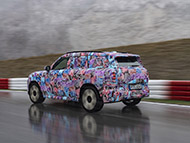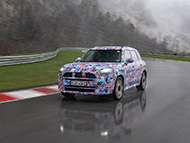From Mini Press Release
The new MINI Countryman combines electrified go-kart feeling with a minimal ecological footprint and continues the success story of the largest MINI model. The start of production at the BMW Group Plant Leipzig in November 2023 will be the first time a MINI model is produced in Germany.
As a stylish all-rounder and spacious everyday companion, the MINI Countryman continues the MINI brand's product offensive of all-electric models.
With five doors and a variable-use interior, the largest model in the new MINI family of vehicles is leading the brand into an era of locally emission-free electromobility. With its optional all-wheel drive, the powerfully powered adventurer also ensures safe and unbridled driving pleasure off the beaten track.
The first generation of the MINI Countryman was already an instant
success for MINI, and from 2010 it expanded the model family to include a compact SUV vehicle with all-wheel drive, five doors and - for the first time in a MINI model - over four meters in length. In the first generation, the trunk of the versatile adventurer can be flexibly expanded from 370 litres to up to 1,170 litres thanks to the sliding and folding rear seat.
From 2017, the second-generation MINI Countryman featured the MINI Cooper SE Countryman ALL4 as the first plug-in hybrid MINI model to offer an additional 65 kW/88 hp electric motor on the rear axle.
The new generation of the largest MINI model is fully electric and locally emission-free. The MINI Countryman E delivers 140 kW/191 hp, whereas the MINI Countryman SE ALL4 is the brand's first all-wheel-drive fully- electric vehicle. Two highly integrated drive units on the front and rear axles together generate an output of 230 kW/313 hp, including a temporary boost. The battery capacity is 64.7 kWh. With an estimated range of around 450 kilometres, the MINI Countryman feels just as comfortable in city centres as on longer distances across the countryside. With the all-electric MINI Countryman, MINI is further expanding the proportion of electrified models. Every fifth MINI is already electric today.
With its length increased by 13 centimetres to 4,429 mm, the spacious adventurer offers even more space and comfort for its occupants. The height grew by almost six centimetres to now 1,613 mm, offering even more headroom.
The new MINI Countryman combines locally emission-free electromobility with the greatest possible environmental compatibility in production as well. This includes dispensing with all decorative elements in the exterior and interior and manufacturing the cast light-alloy wheels from up to 70 percent secondary aluminium. In combination with the use of green electricity in production, CO2 emissions can be significantly reduced compared with conventional manufacturing processes.
The surfaces of the dashboards, steering wheel, vehicle headliner and floor, and floor mats are made of recycled polyester obtained from PET bottles and carpet remnants. This high- quality, colourful and comfortable alternative to traditional materials reduces CO2 emissions along the value chain by up to 85 percent and emphasizes the focus on minimizing the ecological footprint of the next MINI model generation.
The long-term sustainable strategy for energy generation and consumption of the BMW Group's "green plant" at the Leipzig site includes four wind turbines with a height of 190 meters on the factory premises. This could generate more than 20 GWh of electricity from wind energy per year. In the Battery Farm up to 700 second-life high-voltage batteries from BMW i3 vehicles are used to store energy, such as that generated by the wind turbines. By storing the energy on the premises, local energy management can be optimised and the electrical grid kept stable. The decarbonization of production by replacing fossil fuels with hydrogen is the focus of what is already one of the most modern and sustainable automotive production facilities in the world.
Fuel consumption, CO2 emission figures and power consumption were measured using the methods required according to Regulation VO (EC) 2007/715 as amended. They refer to vehicles on the German automotive market. For ranges, the NEDC figures take into account differences in the selected wheel and tyre size, while the WLTP figures take into account the effects of any optional equipment. For vehicles newly type-approved since 01.01.2021, the official specifications exist only according to WLTP. In addition, according to EU Regulation 2022/195, the NEDC values will no longer be included in the EC certificates of conformity as of 01.01.2023.
All figures have already been calculated based on the new WLTP test cycle. NEDC figures listed have been adjusted to the NEDC measurement method where applicable. WLTP values are used as a basis for the assessment of taxes and other vehicle-related duties which are (also) based on CO2 emissions and, where applicable, for the purposes of vehicle-specific subsidies. Further information on the WLTP and NEDC measurement procedures is also available at www.bmw.de/wltp.
For further details of the official fuel consumption figures and official specific CO2 emissions of new cars, please refer to the “Manual on the fuel consumption, CO2 emissions and power consumption of new cars”, available at sales outlets free of charge, from Deutsche Automobil Treuhand GmbH (DAT), Hellmuth-Hirth-Str. 1, 73760 Ostfildern-Scharnhausen and at https://www.dat.de/co2/.







